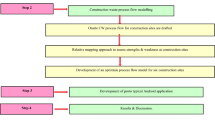Abstract
Large-scaled construction projects with their complex logistical processes of transport, handling and storage material to site, on site and from site bear significant environmental impacts. Such impacts include use of land, production of waste and emissions. In this paper, we investigate—by using a case study approach—how a well-planed implemented material management can affect efficiency in construction logistics focusing on logistics of disposal. The motivation behind this research is to examine the ecological and economic impact of construction logistics on waste management on site, when construction logistics is planned and determined in the early planning phase of a refurbishment project. We find that the implementation of a waste management plan can reduce environmental impacts, specifically increasing the efficiency of logistics of disposal by approximately 9 %, but it is associated with higher costs. The findings gained from this single case study research lead to case-study-specific recommendations for practitioners and regulators in the construction logistics area.







Similar content being viewed by others
References
Baxter P, Jack S (2008) Qualitative case study methodology: study design and implementation for novice researchers. Qual Rep 13(4):544–559
Boenert L, Blömeke M (2003) Logistics concepts in the prefabricated construction industry for increasing cost leadership (Logistikkonzepte im Schlüsselfertigbau zur Erhöhung der Kostenführerschaft). Bauingenieur 78:277–283
Bruns K (1997) Analysis and evaluation of reverse logistics systems—economic, ecological and social aspects (Analyse und Beurteilung von Entsorgungslogistiksystemen—Ökonomische, Ökologische und gesellschaftliche Aspekte). Deutscher Universitätsverlag, Wiesbaden
Deutsche Gesellschaft für Nachhaltiges Bauen (2012) Gold. Silver. Bronze. The assessment. http://www.dgnb-system.de/dgnb-system/en/system/gold-silver-bronze/. Accessed 29 Dec 2012
Dörmann JW (2012) Construction logistics—transparent communication as a means to success (Baulogistik—transparente Kommunikation als Mittel zum Erfolg). UnternehmerBrief Bauwirtschaft 11:3–9
Ebel G (2012) Process model for the requirements analysis in construction logistics (Vorgehensmodell für die Anforderungsanalyse in der Baulogistik). Dissertation, Technische Universität Dortmund
Eisenhardt KM (1989) Building theories from case study research. Acad Manag Rev 14(4):532–550
Ellram L (1996) The use of the case study method in logistics research. J Bus Logist 17(2):93–138
Hasenclever T et al (2011) Logistics Management in the construction industry (Logistikmanagement in der Bauwirtschaft). In: Günther W, Borrmann A (eds) Digitale Baustelle—innovativer Planen, effizienter Ausführen, 1st edn. Springer, Berlin, pp 205–287. doi:10.1007/978-3-642-16486-6_5
Hemer J, Kimpeler S, Lindner T (2007) IT-base eco-efficient potentials on the example of the location of Baden-Württemberg. FAZIT-Schriftenreihe, Band 9. http://www.fazit-forschung.de/fileadmin/_fazit-forschung/downloads/FAZIT_Schriftenreihe_Band_9.pdf. Accessed 29 Dec 2012
Huppes G, Ishikawa M (2005) Why Eco-efficiency? J Ind Ecol 9(4):43–46
Kim I, Min H (2012) Green supply chain research: past, present, and future. Logist Res 4(1–2):39–47
Krauß S (2005) Construction logistics in the turnkey construction (Die Baulogistik in der schlüsselfertigen Ausführung). Dissertation, Universität Stuttgart
Krauß S (2006) Organizational models for construction logistics in Germany (Organisationsmodelle für die Baulogistik in Deutschland). In: Clausen U (ed) Baulogistik—Konzepte für eine bessere Ver-und Entsorgung im Bauwesen, 1st edn. Praxiswissen Service, Dortmund, pp 17–27
Lipsmeier K (2004) Waste figures for new construction of high-rise buildings—structural design and construction projects in building construction according to waste management aspects (Abfallkennzahlen für Neubauleistungen im Hochbau—Hochbaukonstruktionen und Neubauvorhaben im Hochbau nach abfallwirtschaftlichen Gesichtspunkten). Dissertation, Technische Universität Dresden
Lipsmeier K, Ghabel M (1999) Waste management systems in the construction management practice—the recycling-oriented construction site for high-rise buildings (Abfallmanagementsysteme in der baubetrieblichen Praxis—Der recyclingorientierte Baustellenbetrieb für den Hochbau). Bautechnik 76(5):362–367
Meredith J (1998) Building operations management theory through case and field research. J Oper Manag 16:441–454
del Río Merino M, Izquierdo Gracia P, Weis Azevedo IS (2010) Sustainable construction: construction and demolition waste reconsidered. Waste Manag Res. doi: 10.1177/0734242X09103841
Müller K, Sturm A (2001) Standardized eco-efficiency indicators. http://www.ellipson.com/files/studies/EcoEfficiency_Indicators_e.pdf. Accessed 29 Dec 2012
Pfohl H-C (2000) Logistics systems. Business fundamentals (Logistiksysteme. Betriebswirtschaftliche Grundlagen). Springer, Berlin
Pfohl H-C, Engelke M (1995) Instrumental approaches to environmental and economic assessment of disposal logistics processes (Instrumentelle Ansätze einer ökologischen und ökonomischen Beurteilung entsorgungslogistischer Prozesse). In: Pfohl H-C (ed) Arbeitspapiere zur Logistik (19). Technische Universität Darmstadt Institut für Betriebswirtschaftslehre, Darmstadt
Schach R, Schubert N (2009) Logistics in construction industry (Logistik im Bauwesen). Wissenschaftliche Zeitschrift der TU Dresden 58(1–2):59–63
Schmidt N (2003) Competitive factor construction logistics, new value-added potentials in the materials supply chain (Wettbewerbsfaktor Baulogistik Neue Wertschöpfungspotenziale in der Baustoffversorgung). Deutscher Verkehrs-Verlag, Hamburg
Shen LY, Wu YZ, Chan EHW, Hao JL (2005) Application of system dynamics for assessment of sustainable performance of construction projects. J Zhejiang Univ Sci 6A(4):339–349
U.S. Green Building Council (2012) LEED (Leadership in Energy and Environmental Design) http://new.usgbc.org/. Accessed 29 Dec 2012
Weber J (2007) Simulation of logistic processes at construction sites based on 3D CAD data (Simulation von Logistikprozessen auf Baustellen auf Basis von 3D-CAD Daten). Dissertation, Universität Dortmund
Wildemann H (2000) Logistics of disposal (Entsorgungslogistik). In: Bilitewski et al (eds) Müllhandbuch, Erich Schmidt Verlag, Berlin, 1580-Band 2, Lfg. 4/00
Yin RK (2008) Case study research: design and methods. SAGE Publications, Thousand Oaks, CA
Zimmermann J, Haas BH (2009) Construction logistics: motivation-definition-conceptualisation (Baulogistik: Motivation-Definition-Konzeptentwicklung). Tiefbau 1:11–16
Acknowledgments
The authors would like to thank the European Project ZeroWIN that is grant funded by the European Commission Framework Programme 7 for funding part of this work.
Author information
Authors and Affiliations
Corresponding author
Rights and permissions
About this article
Cite this article
Tischer, A., Besiou, M. & Graubner, CA. Efficient waste management in construction logistics: a refurbishment case study. Logist. Res. 6, 159–171 (2013). https://doi.org/10.1007/s12159-013-0105-5
Received:
Accepted:
Published:
Issue Date:
DOI: https://doi.org/10.1007/s12159-013-0105-5




